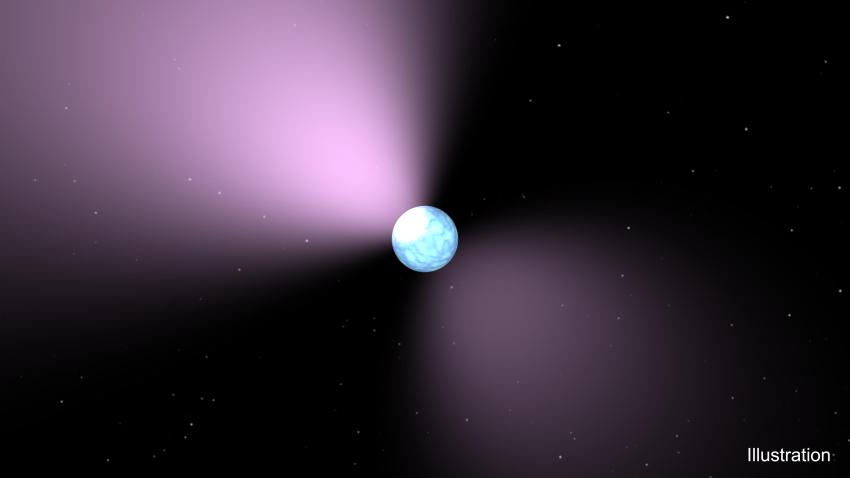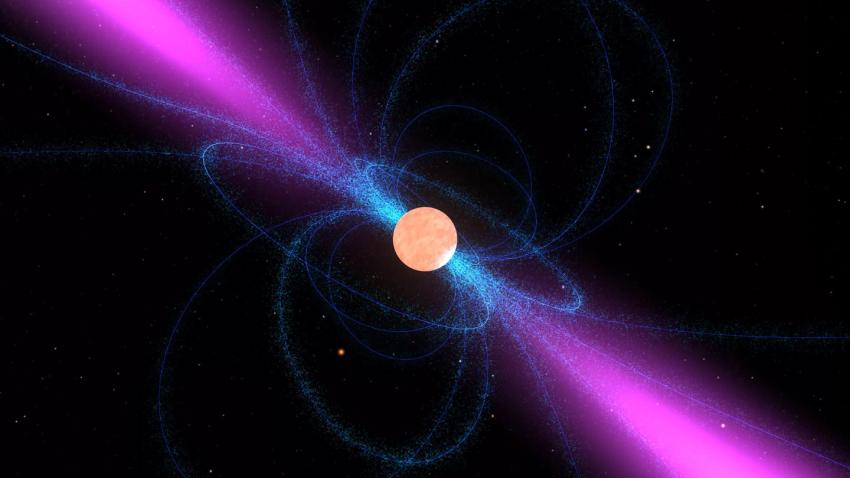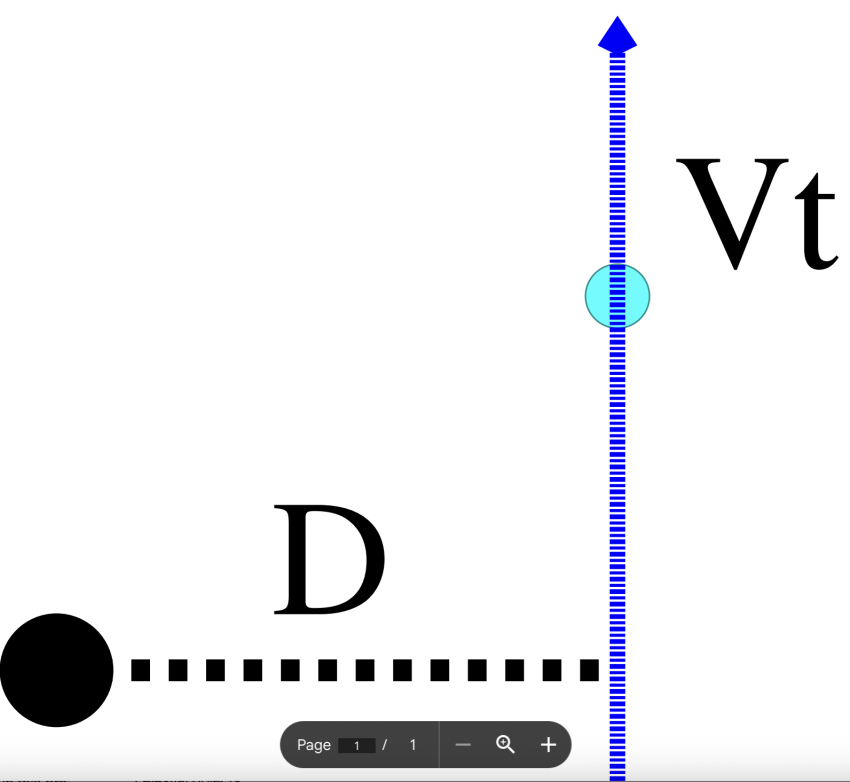Tantalising evidence of potential dark matter objects has been detected with the help of the Universe’s ‘timekeepers’.
These pulsars – neutron stars which rotate and emit lighthouse-like beams of radio waves that rapidly sweep through space – were used to identify mysterious hidden masses.
Pulsars earned their nickname because they send out electromagnetic radiation at very regular intervals, ranging from milliseconds to seconds, making them extremely accurate timekeepers.
“Science has developed very precise methods to measure time,” said the astronomer behind the research, Professor John LoSecco, of the University of Notre Dame, who is presenting his findings at this week’s National Astronomy Meeting at the University of Hull.
“On Earth we have atomic clocks and in space we have pulsars.
“While gravitation has been known to slow down light for more than a century, there have been very few applications so far.”
Professor LoSecco observed variations and delays in pulsar timings, indicating that the radio beams are travelling around an unseen concentration of mass somewhere between the pulsar and the telescope.
He believes these invisible masses are candidates for dark matter objects.
Professor LoSecco studied delays in the arrival times of radio pulses, which normally have nanosecond accuracy. He searched along the path of radio pulses within the PPTA2 survey data release from the Parkes Pulsar Timing Array.
This ongoing project produces precise measurements of pulse arrival times using data from seven different radio telescopes: Effelsberg, Nançay, Westerbork, Green Bank, Arecibo, Parkes and Lovell, the latter in Cheshire.
The pulses have a cadence of approximately three weeks in three observing bands.
Deviations in the arrival times due to dark matter have a well-defined shape and a size proportional to its mass.
Light passing near regions of dark matter will be slowed by its presence. A search of the precision data from 65 ‘millisecond pulsars’ has revealed around a dozen incidents that appear to be interactions with dark matter.
Professor LoSecco said: “We take advantage of the fact that the Earth is moving, the Sun is moving, the pulsar is moving, and even the dark matter is moving.
“We observe the deviations in the arrival time caused by the change in distance between the mass we are observing and the line of sight to our ‘clock’ pulsar.”
A mass the size of the Sun can produce a delay of about 10 microseconds. The observations Professor LoSecco made have resolutions of the order of nanoseconds, 10,000 times smaller.
“One of the findings suggests a distortion of about 20 per cent of the mass of the Sun,” Professor LoSecco said. “This object could be a candidate for dark matter.”
He also confirmed that a side effect of this research is that it improves the pulsar timing data sample. This precision sample has been collected to look for evidence of low-frequency gravitational radiation.
Dark matter objects add ‘noise’ to that data, so identifying and removing them will clean the samples of some variability, eliminating such noise during other searches for gravitational radiation.
“The true nature of dark matter is a mystery,” said Professor LoSecco. “This research sheds new light on the nature of dark matter and its distribution in the Milky Way and may also improve the accuracy of the precision pulsar data.”
Media contacts
Sam Tonkin
Royal Astronomical Society
Mob: +44 (0)7802 877 700
press@ras.ac.uk
Dr Robert Massey
Royal Astronomical Society
Mob: +44 (0)7802 877 699
press@ras.ac.uk
Megan Eaves
Royal Astronomical Society
press@ras.ac.uk
Science contacts
Professor John LoSecco
University of Notre Dame
losecco@nd.edu
Images and captions
Caption: This artist's concept shows a pulsar, which is like a lighthouse, as its light appears in regular pulses as it rotates. Pulsars are dense remnants of exploded stars, and are part of a class of objects called neutron stars. http://photojournal.jpl.nasa.gov/catalog/PIA21085
Credit: NASA/JPL-Caltech
Caption: This image shows an artist's impression of a neutron star, surrounded by its strong magnetic field (blue). It emits a narrow beam of radio waves (magenta) above its magnetic poles. When the star's rotation sweeps these beams over the Earth, the neutron star can be detected as a radio pulsar.
Credit: NASA Goddard/Walt Feimer
Caption: Graph showing the time-dependent geometry of a pulsar. Dark matter cosine as viewed by the observer. The Z axis goes from the observer to the pulsar (dot on the left). The point of closest approach is a distance D along the X axis. The Y coordinate is upward along the projected speed of the mass concentration. The displacement along Y is taken as V t. The mass concentration is in the plane at (D,Vt).
Credit: John LoSecco
Further information
Pulsars were discovered by Professor Dame Jocelyn Bell Burnell in 1967. Burnell was a postgraduate student at New Hall (now Murray Edwards College) carrying out research at Cambridge's Cavendish Laboratory with Antony Hewish.
The term ‘dark matter’ was coined in 1933 by Fritz Zwicky of the California Institute of Technology to describe the unseen matter needed to explain fast-moving galaxies in the Coma Cluster.
Notes for editors
The NAM 2024 conference is principally sponsored by the Royal Astronomical Society (RAS), the Science and Technology Facilities Council (STFC) and the University of Hull.
About the Royal Astronomical Society
The Royal Astronomical Society (RAS), founded in 1820, encourages and promotes the study of astronomy, solar-system science, geophysics and closely related branches of science.
The RAS organises scientific meetings, publishes international research and review journals, recognises outstanding achievements by the award of medals and prizes, maintains an extensive library, supports education through grants and outreach activities and represents UK astronomy nationally and internationally. Its more than 4,000 members (Fellows), a third based overseas, include scientific researchers in universities, observatories and laboratories as well as historians of astronomy and others.
The RAS accepts papers for its journals based on the principle of peer review, in which fellow experts on the editorial boards accept the paper as worth considering. The Society issues press releases based on a similar principle, but the organisations and scientists concerned have overall responsibility for their content.
Keep up with the RAS on X, Facebook, LinkedIn and YouTube.
About the Science and Technology Facilities Council
The Science and Technology Facilities Council (STFC) is part of UK Research and Innovation – the UK body which works in partnership with universities, research organisations, businesses, charities, and government to create the best possible environment for research and innovation to flourish.
STFC funds and supports research in particle and nuclear physics, astronomy, gravitational research and astrophysics, and space science and also operates a network of five national laboratories, including the Rutherford Appleton Laboratory and the Daresbury Laboratory, as well as supporting UK research at a number of international research facilities including CERN, FERMILAB, the ESO telescopes in Chile and many more.
STFC's Astronomy and Space Science programme provides support for a wide range of facilities, research groups and individuals in order to investigate some of the highest priority questions in astrophysics, cosmology and solar system science.
STFC's astronomy and space science programme is delivered through grant funding for research activities, and also through support of technical activities at STFC's UK Astronomy Technology Centre and RAL Space at the Rutherford Appleton Laboratory. STFC also supports UK astronomy through the international European Southern Observatory and the Square Kilometre Array Organisation.
Visit https://stfc.ukri.org/ for more information. Follow STFC on Twitter: @STFC_Matters
About the University of Hull’s E.A. Milne Centre
The E.A. Milne Centre for Astrophysics at the University of Hull brings together experts who study the evolution of structure in the Universe ranging from stars through to galaxies and galaxy clusters, right up to the largest structures in the cosmos.
The centre employs observations, theory and computational methods in collaboration with international partners. Postgraduate and undergraduate students work alongside staff to understand the wonders of the Universe. Through a series of outreach activities, the centre also aims to share its passion for astronomy and astrophysics with the region and beyond.




